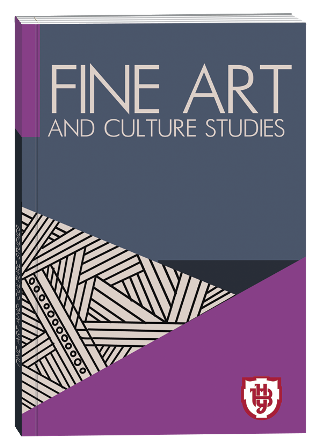ACTUAL PRINCIPLES OF PERFORMANCE INTERPRETATION OF SCHERZO № 4 E-DUR BY FREDERIC CHOPIN IN THE PARADIGM OF THE TRANSFORMATIONAL CHANGE OF THE GENRE
DOI:
https://doi.org/10.32782/facs-2024-5-8Keywords:
evolution, pianism, style, melody, formationAbstract
Frederic Chopin’s work is considered one of the greatest treasures of world art and, at the same time, it is extremely popular among performing musicians and in today’s realities. Having created more than two hundred works for the piano, Chopin is rightly considered one of the bold innovators in art, however, the element of « breaking the old», traditionally associated with innovation, is practically absent in his work: the composer embellished melody, harmony, musical form, interpretation of genres, piano texture and the very sound of the instrument. The fourth scherzo E-dur, to which the article is devoted, is a successful experience of transferring this genre from orchestral music to the piano. Scherzo images created by Chopin, revealed and reproduced by pianists on the concert stage are a constant subject of creative and performing interpretation. The purpose of the article – in the process of analyzing the transformation path of the scherzo genre from the period of its birth to its embodiment in the work of F. Chopin, to substantiate the originality and relevance of the performing interpretation of the scherzo№ 4 E-dur. Research methodology. Analytical, historical-biographical and systematic research approaches were used processing the published materials, identified in the following tasks: 1) to explore the evolutionary path of the scherzo genre; 2) in the process of the performance analysis of the fourth scherzo, to discover innovative means of expression, which, in a certain way, are the basis of the construction of original interpretive concepts. Scientific novelty . In the article, the author presented his own performance idea of the interpretation of Scherzo 4 by F. Chopin, which is based, mainly, on the significant historical foundation of the genre’s development. Conclusion. Chopin assimilated in the rethinking of this genre the achievement of L. Beethoven, who created the classical prototype of the scherzo in his works, and based on it he invented a new genre model, saturating it with deep meaning his scherzos independently developed pieces. In the process of analyzing the most important aspects of the performance inherent in the fourth scherzo, innovative means of expression are evident, which will form the basis of further interpretive versions of the work: melody that has a synthetic character; harmony, exquisite and complex; a special rhythm that incorporates Chopin’s tempo rubato and, finally, the form of a scherzo, which is based on a classical three-part system with features of a sonata and in Chopin’s work develops into a free form. Today, Chopin’s piano style is constantly and systematically studied. Chopin’s music asserts that truly great is the nationally grounded, broadly assimilating achievement of world art, because fruitful is that innovation which serves to embody a new significant content, breaks classical traditions, is distinguished by courage and, at the same time, objective validity.
References
Александрова О.О., Цимбал О.М. Зарубіжна музична література. Ч.2: навч.посіб. Харків, 2021. 123 с.
Волик О.О. Конфігурація піанізму та композиції у творчій свідомості Ф. Шопена. Традиції та новації у вищій архітектурно-художній освіті: зб.наук.праць, Вип 2. Харків, 2018. С. 109–113.
Волик О.О. Поетика етюдів Фридерика Шопена: музикознавча та виконавська інтерпретації: автореф. дис….док. філософії:025.02. Київ, 2021. 226 с.
Івашкевич Я. Шопен: біогр. повість. Київ, 1989. 203 с.
Кашкадамова Н. Історія фортеп’янного мистецтва XIX сторіччя: підручник. Тернопіль: Астон, 2006. 608 с.
Кашкадамова Н. Фортепіанне мистецтво Шопена: науково-методичний нарис. Тернопіль: Астон, 2000. 80 с.
Москаленко В.Г. Про розуміння музичного твору. Наук. вісн. Нац. муз.акад. України ім. П.І. Чайковського: зб. статей.Вип.20. Київ, 2002. С. 3–13.
Москаленко В.Г. Про специфіку музичної інтерпретації. Лекції з музичної інтерпретації: навч. посіб. Київ, 2013. С. 7–34.
Ракул Ю. Про фонічні особливості шопенівського стилю у зв’язку з інструментарієм. Фридерик Шопен. Наук. вісн. Нац. муз. акад. України ім. П.І. Чайковського: зб. ст. Вип.9 Київ, 2000. С. 134–150.
Фридерик Шопен: збірник статей. Львів: Сполом, 2000. 400 с.
Хе Веньлі. Хронотопічні засади фортепіанної творчості Ф. Шопена: інтерпретативно-стильовий підхід: автореф. дис…канд. мистецтвознавства: 17.00.03. Одеса, 2020. 203 с.
Bronarski L. Harmonika Chopina. Warszawa: Tow. Wyd. Muzyki Polskiej, 1935. 480 s.
Chominski J. M. Formy muzyczne. T.1. Krakow: PWM, 1954. 278 s.
Hudson R. Stolen Time: The History of Tempo Rubato. Oxford: Clarendon Press, 1994. 473 p.
Morski K. Interpretations of the Works of Chopin: A Comparative Analysis of Different Styles of Performance. Chopin in Performance: History, Theory, Practice. Warszawa: Narodowy Instytut Fryderyka Chopina, 2004. 164 s.
Tomaczewski M. (2005). Chopin: czlowiek, dzielo, rezonans. Krakow: PWM.
Tomaczewski M. Fenomen i paradoks muzyki Chopina. Ethos, 73/74, 2006. 317–330 s.







